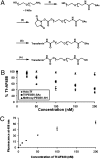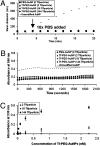Mechanism of active targeting in solid tumors with transferrin-containing gold nanoparticles
- PMID: 20080552
- PMCID: PMC2824286
- DOI: 10.1073/pnas.0914140107
Mechanism of active targeting in solid tumors with transferrin-containing gold nanoparticles
Abstract
PEGylated gold nanoparticles are decorated with various amounts of human transferrin (Tf) to give a series of Tf-targeted particles with near-constant size and electrokinetic potential. The effects of Tf content on nanoparticle tumor targeting were investigated in mice bearing s.c. Neuro2A tumors. Quantitative biodistributions of the nanoparticles 24 h after i.v. tail-vein injections show that the nanoparticle accumulations in the tumors and other organs are independent of Tf. However, the nanoparticle localizations within a particular organ are influenced by the Tf content. In tumor tissue, the content of targeting ligands significantly influences the number of nanoparticles localized within the cancer cells. In liver tissue, high Tf content leads to small amounts of the nanoparticles residing in hepatocytes, whereas most nanoparticles remain in nonparenchymal cells. These results suggest that targeted nanoparticles can provide greater intracellular delivery of therapeutic agents to the cancer cells within solid tumors than their nontargeted analogs.
Conflict of interest statement
The authors declare no conflict of interest.
Figures






Similar articles
-
Increased brain uptake of targeted nanoparticles by adding an acid-cleavable linkage between transferrin and the nanoparticle core.Proc Natl Acad Sci U S A. 2015 Oct 6;112(40):12486-91. doi: 10.1073/pnas.1517048112. Epub 2015 Sep 21. Proc Natl Acad Sci U S A. 2015. PMID: 26392563 Free PMC article.
-
Probing and Enhancing Ligand-Mediated Active Targeting of Tumors Using Sub-5 nm Ultrafine Iron Oxide Nanoparticles.Theranostics. 2020 Jan 22;10(6):2479-2494. doi: 10.7150/thno.39560. eCollection 2020. Theranostics. 2020. PMID: 32194814 Free PMC article.
-
Tumor-targeted and pH-controlled delivery of doxorubicin using gold nanorods for lung cancer therapy.Int J Nanomedicine. 2015 Oct 29;10:6773-88. doi: 10.2147/IJN.S93237. eCollection 2015. Int J Nanomedicine. 2015. PMID: 26604751 Free PMC article.
-
[Transferrin conjugated PEG-liposomes as intracellular targeting carrier for tumor therapy].Nihon Rinsho. 1998 Mar;56(3):657-62. Nihon Rinsho. 1998. PMID: 9549352 Review. Japanese.
-
Polymer decorated gold nanoparticles in nanomedicine conjugates.Adv Colloid Interface Sci. 2017 Nov;249:386-399. doi: 10.1016/j.cis.2017.01.007. Epub 2017 Feb 15. Adv Colloid Interface Sci. 2017. PMID: 28259207 Review.
Cited by
-
Surface Design Options in Polymer- and Lipid-Based siRNA Nanoparticles Using Antibodies.Int J Mol Sci. 2022 Nov 11;23(22):13929. doi: 10.3390/ijms232213929. Int J Mol Sci. 2022. PMID: 36430411 Free PMC article. Review.
-
Multifunctional nanoplatforms co-delivering combinatorial dual-drug for eliminating cancer multidrug resistance.Theranostics. 2021 Apr 19;11(13):6334-6354. doi: 10.7150/thno.59342. eCollection 2021. Theranostics. 2021. PMID: 33995661 Free PMC article. Review.
-
N-Acetylcysteine Nanocarriers Protect against Oxidative Stress in a Cellular Model of Parkinson's Disease.Antioxidants (Basel). 2020 Jul 9;9(7):600. doi: 10.3390/antiox9070600. Antioxidants (Basel). 2020. PMID: 32660079 Free PMC article.
-
MicroRNA Biogenesis is Enhanced by Liposome-Encapsulated Pin1 Inhibitor in Hepatocellular Carcinoma.Theranostics. 2019 Jul 9;9(16):4704-4716. doi: 10.7150/thno.34588. eCollection 2019. Theranostics. 2019. PMID: 31367251 Free PMC article.
-
Strategies in the design of nanoparticles for therapeutic applications.Nat Rev Drug Discov. 2010 Aug;9(8):615-27. doi: 10.1038/nrd2591. Epub 2010 Jul 9. Nat Rev Drug Discov. 2010. PMID: 20616808 Review.
References
-
- Davis ME, Chen ZG, Shin DM. Nanoparticle therapeutics: An emerging treatment modality for cancer. Nat Rev Drug Discov. 2008;7:771–782. - PubMed
-
- Matsumura Y, Maeda H. A new concept for macromolecular therapeutics in cancer chemotherapy: Mechanism of tumoritropic accumulation of proteins and the antitumor agent SMANCS. Cancer Res. 1986;46:6387–6392. - PubMed
-
- Dreher MR, et al. Tumor vascular permeability, accumulation, and penetration of macromolecular drug carriers. J Natl Cancer Inst. 2006;98:335–344. - PubMed
-
- Lopes de Menezes DE, Pilarski LM, Allen TM. In vitro and in vivo targeting of immunoliposomal doxorubicin to human B-cell lymphoma. Cancer Res. 1998;58:3320–3330. - PubMed
Publication types
MeSH terms
Substances
Grants and funding
LinkOut - more resources
Full Text Sources
Other Literature Sources
Miscellaneous

